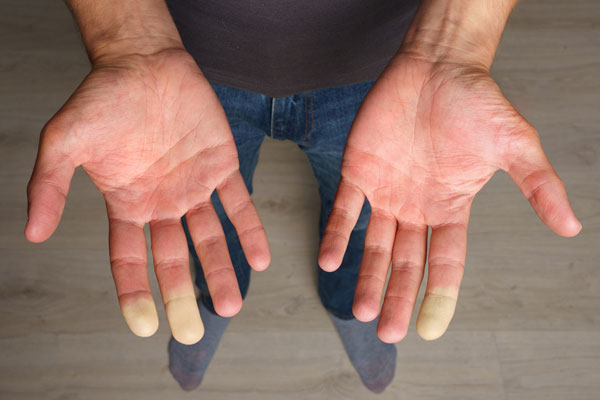
Cold temperatures and stressful situations can be uncomfortable to all of us. But they are especially difficult for people suffering from Raynaud’s disease. Also known as Raynaud’s syndrome and Raynaud’s phenomenon, the condition is named after the doctor who first recognised it: France’s Maurice Raynaud.
Some estimates suggest as many as 10 million people in the UK suffer Raynaud’s symptoms. I see my fair share of patients given that some cases of the disease are linked to inflammatory conditions such as Lupus and Scleroderma.. If, after reading this article, you believe you are exhibiting some of the tell-tale symptoms of Raynaud’s syndrome, by all means contact my office.
What causes Raynauds disease?
You can have a Raynaud’s attack when the small blood vessels within the fingers and toes become over-sensitive to triggers such as cold weather.
Primary Raynaud’s is a milder condition and the most common form of the disease. Medical researchers still don’t know the exact cause of primary Raynaud’s and the condition can occur by itself. Primary Reynaud’s isn’t associated with other health issues.
When we are exposed to cold weather, it is a normal response for the blood vessels in our fingers and toes to constrict. However, for someone with primary Raynaud’s, this blood vessel constriction can be more extreme, causing pain in the extremities and the skin to change colour.
Secondary Raynaud’s disease is much less common with about 10 per cent of people with Raynaud’s having it. Medical researchers believe that another health condition can cause the blood vessels in the extremities to overreact, which leads to secondary Raynaud’s sumptoms.
In most cases of secondary Raynaud’s disease, it is an autoimmune disease that can trigger the condition. An autoimmune disease such as Scleroderma is known to be associated with secondary Raynaud’s, but there are other possibilities, including:
- Carpal tunnel syndrome
- Lupus
- Rheumatoid arthritis
- Sjogren’s syndrome
What type of doctor treats Raynaud’s syndrome?
In most cases your GP will refer you to a doctor that specialises in Raynaud’s, such as a rheumatologist. Specialists such as Dr Bhadauria have the most knowledge of Raynaud’s symptoms and how best to diagnose and treat them.
Raynaud’s phenomenon is primarily treated by rhumatologists because it sometimes occurs in association with rheumatic conditions that affect the joints, muscles and bones.
Constricting of the Blood Vessels
Raynaud’s disease is a condition involving how the blood vessels constrict. Blood vessel constriction is normal as a result of cold temperatures. It happens to all of us. But in Raynaud’s patients, the constriction is especially significant. Their blood vessels get much smaller. As internal temperatures return to normal and blood vessels relax, Raynaud’s patients can suffer significant pain.
There are two types of Raynaud’s disease: primary and secondary. Most cases – estimates suggest as many as 90% – are primary, meaning that there doesn’t appear to be any underlying disease or health condition causing it. Raynaud’s symptoms are the only symptoms the patient presents.
Secondary Raynaud’s disease is the result of some other condition. Lupus is one of them. Others include Scleroderma and even Sjogren’s syndrome. Note that secondary Raynaud’s can be treated alongside the symptoms of the underlying condition.
Common Raynaud’s Symptoms
Raynaud’s symptoms almost always present when a person is experiencing cold temperatures or an especially stressful circumstance. Symptoms include:
- numb, painful, and stiff extremities
- changes in skin colour (white, blue, red)
- feelings of pins and needles
- painful throbbing
- increased sensitivity.
Patients commonly experience symptoms in the fingertips, toes, hands, and feet. However, Raynaud’s can also affect the nose, lips, ears, tongue, and nipples. Changes in skin colour are the direct result of a lack of oxygen due to decreased blood flow. Skin normally turns white at first, then blue. Restored circulation results in a red colour as blood rushes back to the surface of the skin.
Common Raynaud’s Treatments
If Raynaud’s symptoms are the result of an underlying condition, any treatments will be in concert with that condition. Primary Raynaud’s patients may be offered a medication known as nifedipine; a drug normally used to treat hypertension.
Most doctors also recommend the following:
- Regular exercise to improve circulation
- Strategies and techniques for reducing stress
- Avoiding both alcohol and tobacco
- Limiting caffeine intake
- Eating a healthy and balanced diet.
When attacks are likely to increase – like during the winter months, for example – patients can take advantage of some simple strategies to decrease the pain and discomfort. Wearing extra layers usually helps. Heating pads can improve circulation and reduce pain. Even raising the temperature inside your house by a degree or two can help quite a bit.
Unfortunately, there is no cure for Raynaud’s disease. The best that medical science can do is help patients manage the disease in order to minimise discomfort. That is one of my goals as a private rheumatologist in London.
Again, please make an appointment with my office if you are exhibiting symptoms of Raynaud’s disease. A thorough examination should uncover whether or not you suffer from the condition. And if you do, we should be able to tell whether it is primary or secondary.
Article by Dr. Naveen Bhadauria



